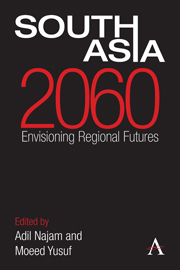Book contents
- Frontmatter
- Contents
- Acknowledgments
- List of Abbreviations
- Introduction: Imagining South Asian Futures
- Section I South Asia as a Region
- Chapter 1 Prisoners or Masters of Destiny?
- Chapter 2 South Asian Futures: Three Scenarios
- Chapter 3 Federalism on the Road: Region and Regionalism
- Chapter 4 Diversity in South Asia
- Chapter 5 Future's Past
- Section II State Relations
- Section III Development
- Section IV Human Well-Being
- About the Authors
- Bibliography
- Index
Chapter 5 - Future's Past
from Section I - South Asia as a Region
Published online by Cambridge University Press: 05 September 2013
- Frontmatter
- Contents
- Acknowledgments
- List of Abbreviations
- Introduction: Imagining South Asian Futures
- Section I South Asia as a Region
- Chapter 1 Prisoners or Masters of Destiny?
- Chapter 2 South Asian Futures: Three Scenarios
- Chapter 3 Federalism on the Road: Region and Regionalism
- Chapter 4 Diversity in South Asia
- Chapter 5 Future's Past
- Section II State Relations
- Section III Development
- Section IV Human Well-Being
- About the Authors
- Bibliography
- Index
Summary
Introduction
Prophets are best at predicting the future – though, they tend towards the dystopic and the apocalyptic. The more philosophically inclined among us, when asked to imagine the future, create utopias secluded in the woods or contained on an island – in other words, by clearing away the accretions of the past and the unseemly present. Everyone else tends to read the best or the worst of the present moment and write it into the future – cars replaced by flying cars, cities replaced by mega cities, wars replaced by greater wars and so on. Such is the grasp that the present has on us – it is always natural, progressive, rational and just so. Historians, being neither prophets nor philosophers, usually have no thoughts on the future. We are busy figuring out what happened, why it did not happen some other way and why we should care it happened the way it did. But we do have a charge to unsettle whatever “truths” seem above reproach in our presents, to question basic assumptions of how things appear now and to argue for an imagination that ponders all possible futures, not just the ones that seem predestined.
My claim, as a historian, is simple: The “South Asia” we inhabit is a recent construct. It is a limited and restrictive political space as compared to more than a thousand years of textual history and thousands more in material and cultural memory. The stories it currently tells are themselves limited, the imaginations it cultivates are themselves rigid. The geographies that seem so indelible, so permanent, are mere shadows upon regional perspectives that are still legible movement and life patterns, in languages, in customs, and in cultural imaginations.
- Type
- Chapter
- Information
- South Asia 2060Envisioning Regional Futures, pp. 46 - 52Publisher: Anthem PressPrint publication year: 2013



